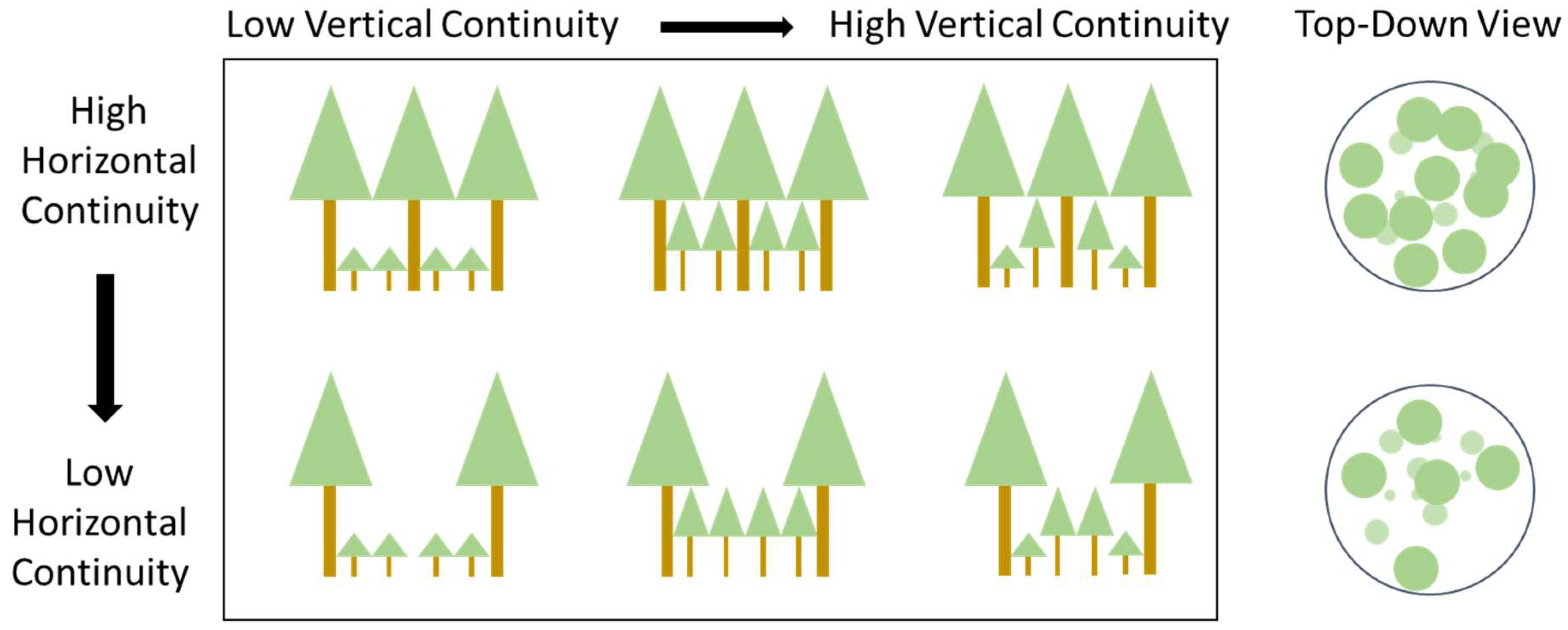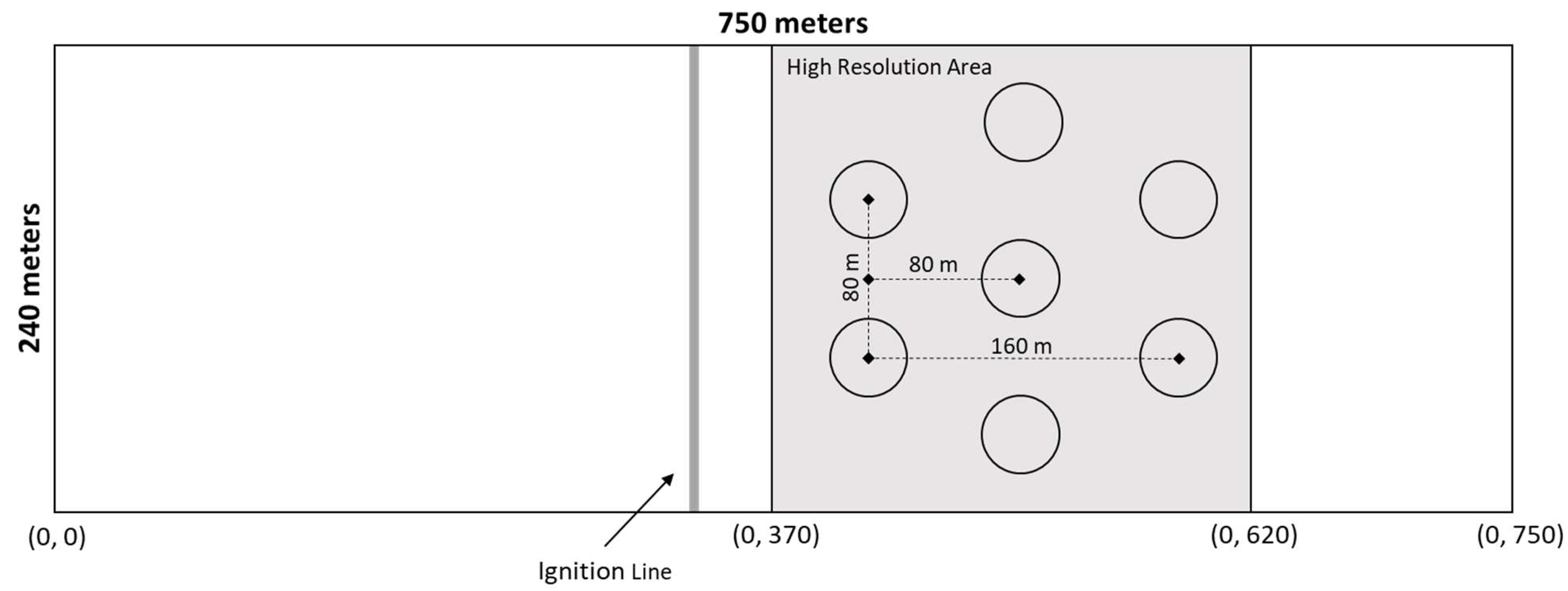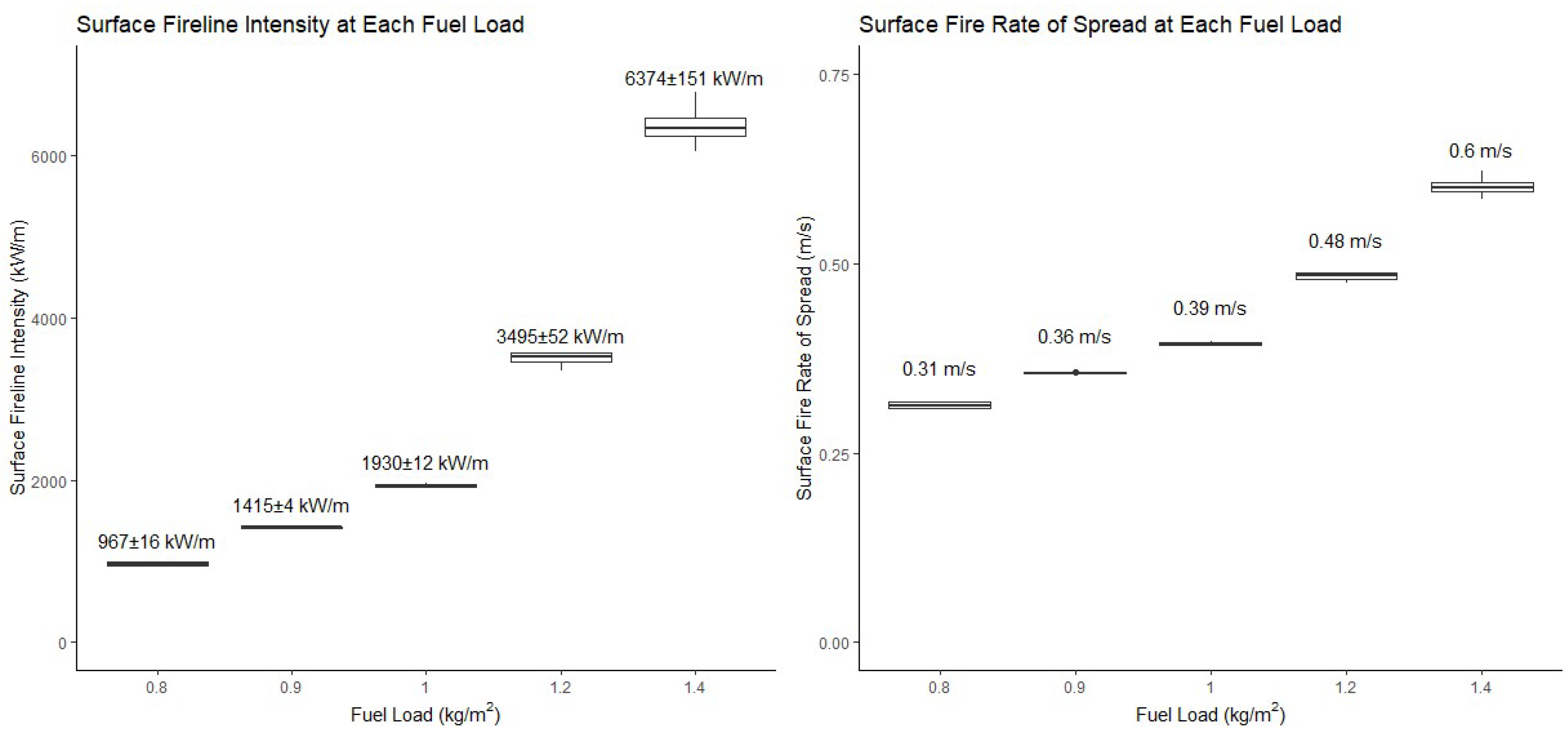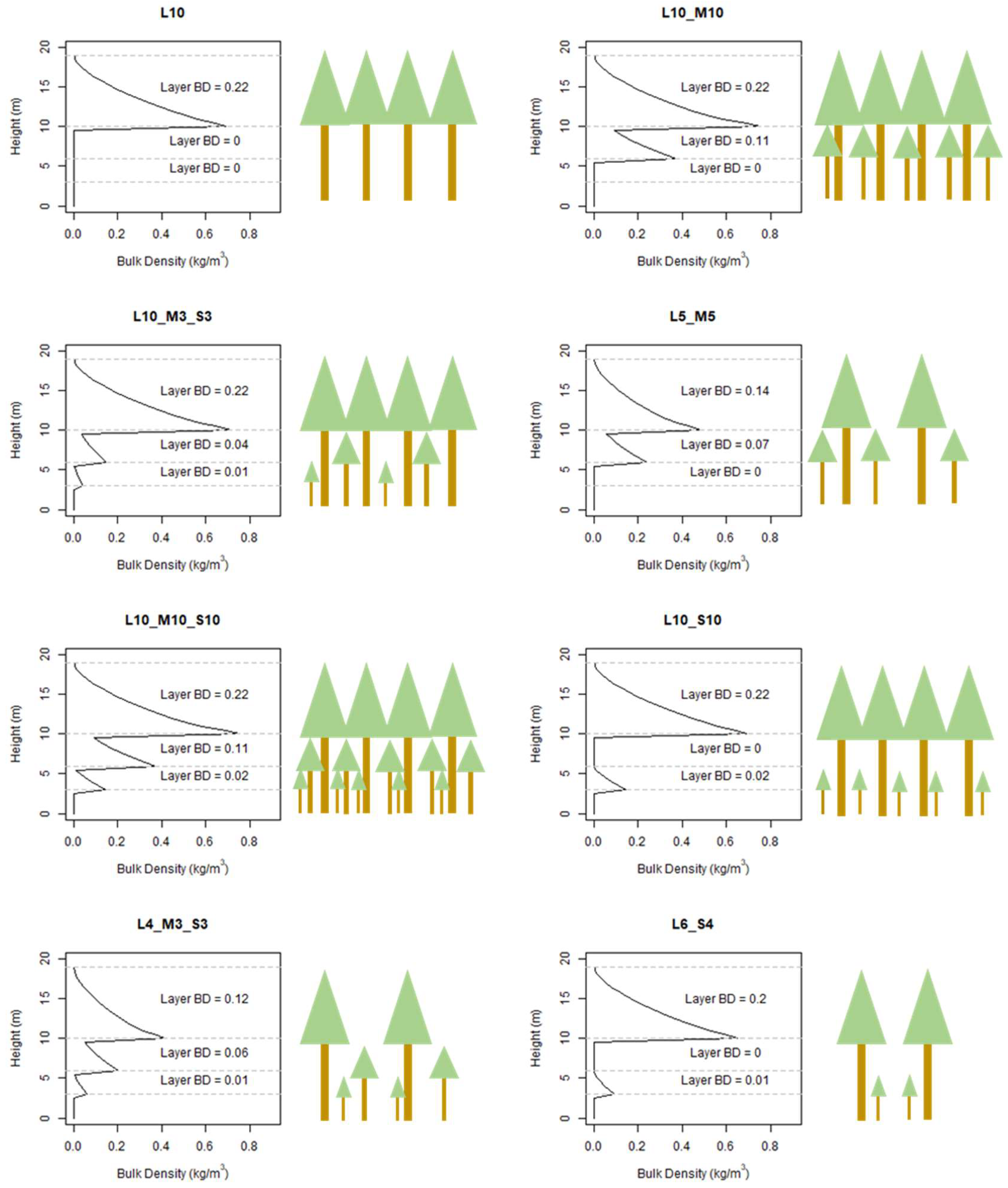Vertical and Horizontal Crown Fuel Continuity Influences Group-Scale Ignition and Fuel Consumption
Abstract
:1. Introduction
2. Materials and Methods
2.1. Fire Model
2.2. Fire Simulations and Domain
2.3. Tree Dimensions and Parameters
2.4. Tree Mixtures
2.5. Surface Fuels
2.6. Data Analysis
3. Results and Discussion
3.1. Horizontal and Vertical Continuity
3.2. Large-Tree Consumption
4. Conclusions
Author Contributions
Funding
Institutional Review Board Statement
Informed Consent Statement
Data Availability Statement
Conflicts of Interest
References
- North, M.; Collins, B.M.; Stephens, S. Using Fire to Increase the Scale, Benefits, and Future Maintenance of Fuels Treatments. J. For. 2012, 110, 392–401. [Google Scholar] [CrossRef]
- North, M.; Brough, A.; Long, J.; Collins, B.; Bowden, P.; Yasuda, D.; Miller, J.; Sugihara, N. Constraints on Mechanized Treatment Significantly Limit Mechanical Fuels Reduction Extent in the Sierra Nevada. J. For. 2015, 113, 40–48. [Google Scholar] [CrossRef]
- Stephens, S.L.; Collins, B.M.; Biber, E.; Fulé, P.Z.U.S. Federal Fire and Forest Policy: Emphasizing Resilience in Dry Forests. Ecosphere 2016, 7, e01584. [Google Scholar] [CrossRef]
- Schoennagel, T.; Balch, J.K.; Brenkert-Smith, H.; Dennison, P.E.; Harvey, B.J.; Krawchuk, M.A.; Mietkiewicz, N.; Morgan, P.; Moritz, M.A.; Rasker, R.; et al. Adapt to More Wildfire in Western North American Forests as Climate Changes. Proc. Natl. Acad. Sci. USA 2017, 114, 4582–4590. [Google Scholar] [CrossRef]
- Van Wagner, C.E. Conditions for the Start and Spread of Crown Fire. Can. J. For. Res. 1977, 7, 23–34. [Google Scholar] [CrossRef]
- Xanthopoulos, G. Development of a Wildland Crown Fire Initiation Model. Ph.D. Thesis, University of Montana, Missoula, MT, USA, 1990. [Google Scholar]
- Alexander, M. Crown Fire Thresholds in Exotic Pine Plantations of Australasia. Ph.D. Thesis, Australian National University, Canberra, Australia, 1998. [Google Scholar]
- Cruz, M.G.; Butler, B.W.; Alexander, M.E.; Forthofer, J.M.; Wakimoto, R.H. Predicting the Ignition of Crown Fuels above a Spreading Surface Fire. Part I: Model Idealization. Int. J. Wildland Fire 2006, 15, 47. [Google Scholar] [CrossRef]
- Loudermilk, E.L.; O’Brien, J.J.; Mitchell, R.J.; Cropper, W.P.; Hiers, J.K.; Grunwald, S.; Grego, J.; Fernandez-Diaz, J.C. Linking Complex Forest Fuel Structure and Fire Behaviour at Fine Scales. Int. J. Wildland Fire 2012, 21, 882. [Google Scholar] [CrossRef]
- Ziegler, J.P.; Hoffman, C.; Battaglia, M.; Mell, W. Spatially Explicit Measurements of Forest Structure and Fire Behavior Following Restoration Treatments in Dry Forests. For. Ecol. Manag. 2017, 386, 1–12. [Google Scholar] [CrossRef]
- Parsons, R.; Linn, R.; Pimont, F.; Hoffman, C.; Sauer, J.; Winterkamp, J.; Sieg, C.; Jolly, W. Numerical Investigation of Aggregated Fuel Spatial Pattern Impacts on Fire Behavior. Land 2017, 6, 43. [Google Scholar] [CrossRef]
- Ritter, S.M.; Hoffman, C.M.; Battaglia, M.A.; Stevens-Rumann, C.S.; Mell, W.E. Fine-scale Fire Patterns Mediate Forest Structure in Frequent-fire Ecosystems. Ecosphere 2020, 11, e03177. [Google Scholar] [CrossRef]
- Stephens, S.L.; Battaglia, M.A.; Churchill, D.J.; Collins, B.M.; Coppoletta, M.; Hoffman, C.M.; Lydersen, J.M.; North, M.P.; Parsons, R.A.; Ritter, S.M.; et al. Forest Restoration and Fuels Reduction: Convergent or Divergent? BioScience 2020, 71, 85–101. [Google Scholar] [CrossRef]
- Larson, A.J.; Churchill, D. Tree Spatial Patterns in Fire-Frequent Forests of Western North America, Including Mechanisms of Pattern Formation and Implications for Designing Fuel Reduction and Restoration Treatments. For. Ecol. Manag. 2012, 267, 74–92. [Google Scholar] [CrossRef]
- Churchill, D.J.; Larson, A.J.; Dahlgreen, M.C.; Franklin, J.F.; Hessburg, P.F.; Lutz, J.A. Restoring Forest Resilience: From Reference Spatial Patterns to Silvicultural Prescriptions and Monitoring. For. Ecol. Manag. 2013, 291, 442–457. [Google Scholar] [CrossRef]
- Ziegler, J.P.; Hoffman, C.M.; Collins, B.M.; Knapp, E.E.; Mell, W.R. Pyric Tree Spatial Patterning Interactions in Historical and Contemporary Mixed Conifer Forests, California, USA. Ecol. Evol. 2021, 11, 820–834. [Google Scholar] [CrossRef]
- Kim, D.-W.; Chung, W.; Lee, B. Exploring Tree Crown Spacing and Slope Interaction Effects on Fire Behavior with a Physics-Based Fire Model. For. Sci. Technol. 2016, 12, 167–175. [Google Scholar] [CrossRef]
- Atchley, A.L.; Linn, R.; Jonko, A.; Hoffman, C.; Hyman, J.D.; Pimont, F.; Sieg, C.; Middleton, R.S. Effects of Fuel Spatial Distribution on Wildland Fire Behaviour. Int. J. Wildland Fire 2021, 30, 179. [Google Scholar] [CrossRef]
- Menning, K.M.; Stephens, S.L. Fire Climbing in the Forest: A Semiqualitative, Semiquantitative Approach to Assessing Ladder Fuel Hazards. West. J. Appl. For. 2007, 22, 88–93. [Google Scholar] [CrossRef]
- Marino, E.; Montes, F.; Tomé, J.L.; Navarro, J.A.; Hernando, C. Vertical Forest Structure Analysis for Wildfire Prevention: Comparing Airborne Laser Scanning Data and Stereoscopic Hemispherical Images. Int. J. Appl. Earth Obs. Geoinform. 2018, 73, 438–449. [Google Scholar] [CrossRef]
- Tachajapong, W.; Lozano, J.; Mahalingam, S.; Zhou, X.; Weise, D.R. Experimental and Numerical Modeling of Shrub Crown Fire Initiation. Combust. Sci. Technol. 2009, 181, 618–640. [Google Scholar] [CrossRef]
- Padhi, S.; Shotorban, B.; Mahalingam, S. A Computational Study of the Interactions of Three Adjacent Burning Shrubs Subjected to Wind. Fire Saf. J. 2017, 91, 749–757. [Google Scholar] [CrossRef]
- Shannon, W.; Anand, C.; Shotorban, B.; Mahalingam, S. Fire Behavior in Multiple Burning Shrubs Separated Horizontally and Vertically. Fire Saf. J. 2020, 118, 103236. [Google Scholar] [CrossRef]
- Van Wagner, C.E. Prediction of Crown Fire Behavior in Two Stands of Jack Pine. Can. J. For. Res. 1993, 23, 442–449. [Google Scholar] [CrossRef]
- Cruz, M.G.; Alexander, M.E.; Wakimoto, R.H. Development and Testing of Models for Predicting Crown Fire Rate of Spread in Conifer Forest Stands. Can. J. For. Res. 2005, 35, 1626–1639. [Google Scholar] [CrossRef]
- Mell, W.; Jenkins, M.A.; Gould, J.; Cheney, P.; Mell, W.; Jenkins, M.A.; Gould, J.; Cheney, P. A Physics-Based Approach to Modelling Grassland Fires. Int. J. Wildland Fire 2007, 16, 1–22. [Google Scholar] [CrossRef]
- Morvan, D.; Dupuy, J.L. Modeling the Propagation of a Wildfire through a Mediterranean Shrub Using a Multiphase Formulation. Combust. Flame 2004, 138, 199–210. [Google Scholar] [CrossRef]
- Mell, W.; Maranghides, A.; McDermott, R.; Manzello, S.L. Numerical Simulation and Experiments of Burning Douglas Fir Trees. Combust. Flame 2009, 156, 2023–2041. [Google Scholar] [CrossRef]
- McGrattan, K.; Hostikka, S.; McDermott, R.; Floyd, J.; Weinschenk, C.; Overholt, K. Fire Dynamics Simulator User’s Guide; US Department of Commerce, Technology Administration, National Institute of Standards and Technology: Gaithersburg, MD, USA, 2005.
- McGrattan, K.; Hostikka, S.; McDermott, R.; Floyd, J.; Weinschenk, C.; Overholt, K. Fire Dynamics Simulator Technical Reference Guide Volume 2: Verification; US Department of Commerce, Technology Administration, National Institute of Standards and Technology: Gaithersburg, MD, USA, 2013.
- McGrattan, K.; Hostikka, S.; McDermott, R.; Floyd, J.; Weinschenk, C.; Overholt, K. Fire Dynamics Simulator Technical Reference Guide Volume 3: Validation; US Department of Commerce, Technology Administration, National Institute of Standards and Technology: Gaithersburg, MD, USA, 2013.
- Castle, D.; Mell, W.E.; Miller, F.J. Examination of the Wildland-Urban Interface Fire Dynamics Simulator in Modeling of Laboratory-Scale Surface-to-Crown Fire Transition. In Proceedings of the 8th US National Combustion Meeting, Park City, UT, USA, 19 May 2013. [Google Scholar]
- Mueller, E.; Mell, W.; Simeoni, A. Large Eddy Simulation of Forest Canopy Flow for Wildland Fire Modeling. Can. J. For. Res. 2014, 44, 1534–1544. [Google Scholar] [CrossRef]
- Overholt, K.J.; Cabrera, J.; Kurzawski, A.; Koopersmith, M.; Ezekoye, O.A. Characterization of Fuel Properties and Fire Spread Rates for Little Bluestem Grass. Fire Technol. 2014, 50, 9–38. [Google Scholar] [CrossRef]
- Hoffman, C.M.; Canfield, J.; Linn, R.R.; Mell, W.; Sieg, C.H.; Pimont, F.; Ziegler, J. Evaluating Crown Fire Rate of Spread Predictions from Physics-Based Models. Fire Technol. 2016, 52, 221–237. [Google Scholar] [CrossRef]
- Perez-Ramirez, Y.; Mell, W.E.; Santoni, P.A.; Tramoni, J.B.; Bosseur, F. Examination of WFDS in Modeling Spreading Fires in a Furniture Calorimeter. Fire Technol. 2017, 53, 1795–1832. [Google Scholar] [CrossRef]
- Sánchez-Monroy, X.; Mell, W.; Torres-Arenas, J.; Butler, B.W. Fire Spread Upslope: Numerical Simulation of Laboratory Experiments. Fire Saf. J. 2019, 108, 102844. [Google Scholar] [CrossRef]
- Ritter, S.M.; Hoffman, C.M.; Battaglia, M.A.; Jain, T.B. Restoration and Fuel Hazard Reduction Result in Equivalent Reductions in Crown Fire Behavior in Dry Conifer Forests. Ecol. Appl. 2022, 32, e2682. [Google Scholar] [CrossRef] [PubMed]
- Keyser, T.; Smith, F.W. Influence of Crown Biomass Estimators and Distribution on Canopy Fuel Characteristics in Ponderosa Pine Stands of the Black Hills. For. Sci. 2010, 56, 156–165. [Google Scholar]
- Brown, J.K. Physical Fuel Properties of Ponderosa Pine Forest Floors and Cheatgrasses; Intermountain Forest & Range Experiment Station, Forest Service, U.S. Department of Agriculture: Ogden, UT, USA, 1970.
- Brown, J.K. Bulk Densities of Nonuniform Surface Fuels and Their Application to Fire Modeling. For. Sci. 1981, 27, 667–683. [Google Scholar] [CrossRef] [PubMed]
- Byram, G.M. Combustion of Forest Fuels; Forest fire: Control and Use; McGraw-Hill: New York, NY, USA, 1959. [Google Scholar]
- R Core Team. R: A Language and Environment for Statistical Computing; R Foundation for Statistical Computing: Vienna, Austria, 2023; Available online: https://www.R-project.org/ (accessed on 12 July 2023).
- Lutz, J.A.; Furniss, T.J.; Johnson, D.J.; Davies, S.J.; Allen, D.; Alonso, A.; Anderson-Teixeira, K.J.; Andrade, A.; Baltzer, J.; Becker, K.M.L.; et al. Global Importance of Large-diameter Trees. Glob. Ecol. Biogeogr. 2018, 27, 849–864. [Google Scholar] [CrossRef]
- Lutz, J.A.; Struckman, S.; Furniss, T.J.; Birch, J.D.; Yocom, L.L.; McAvoy, D.J. Large-Diameter Trees, Snags, and Deadwood in Southern Utah, USA. Ecol. Process. 2021, 10, 9. [Google Scholar] [CrossRef]
- Mobley, C.M.; Eldridge, M. Culturally Modified Trees in the Pacific Northwest. Arct. Anthropol. 1992, 29, 91–110. [Google Scholar]
- Brown, P.M.; Gannon, B.; Battaglia, M.A.; Fornwalt, P.J.; Huckaby, L.S.; Cheng, A.S.; Baggett, L.S. Identifying old trees to inform ecological restoration in montane forests of the central rocky mountains, USA. Tree-Ring Res. 2019, 75, 34. [Google Scholar] [CrossRef]
- Flanary, S.J.; Keane, R.E. Ponderosa Pine Mortality in the Bob Marshall Wilderness after Successive Fires over 14 Years; RMRS-RN-85; U.S. Department of Agriculture, Forest Service, Rocky Mountain Research Station: Fort Collins, CO, USA, 2020. [CrossRef]
- O’Hara, K.L. Multiaged Silviculture: Managing for Complex Forest Stand Structures; Oxford University Press: Oxford, UK, 2014. [Google Scholar]
- Stephens, S.L.; Bigelow, S.W.; Burnett, R.D.; Collins, B.M.; Gallagher, C.V.; Keane, J.; Kelt, D.A.; North, M.P.; Roberts, L.J.; Stine, P.A.; et al. California Spotted Owl, Songbird, and Small Mammal Responses to Landscape Fuel Treatments. BioScience 2014, 64, 893–906. [Google Scholar] [CrossRef]
- Agee, J.K.; Skinner, C.N. Basic Principles of Forest Fuel Reduction Treatments. For. Ecol. Manag. 2005, 211, 83–96. [Google Scholar] [CrossRef]





| Size | DBH (cm) | HT (m) | CBH (m) | CW (m) |
|---|---|---|---|---|
| Large | 40 | 19 | 10 | 5 |
| Medium | 25 | 12.5 | 6.5 | 3.5 |
| Small | 10 | 6 | 3 | 2 |
| Mixture | Number of Trees | Fuel Stratum Gap (m) | ||
|---|---|---|---|---|
| Large | Medium | Small | ||
| L10 | 10 | 0 | 0 | 10 |
| L4_M3_S3 | 4 | 3 | 3 | 3 |
| L5_M5 | 5 | 5 | 0 | 6.5 |
| L6_S4 | 6 | 0 | 4 | 3 |
| L10_M3_S3 | 10 | 3 | 3 | 3 |
| L10_M10_S10 | 10 | 10 | 10 | 3 |
| L10_M10 | 10 | 10 | 10 | 6.5 |
| L10_S10 | 10 | 0 | 10 | 3 |
| Model | Predictors | B | p Value |
|---|---|---|---|
| All Fuel Loads | FLI | 0.99 | <0.0000 |
| Overstory Bulk Density | 0.39 | <0.0000 | |
| Midstory Bulk Density | 0.32 | <0.0000 | |
| 967 kW/m | Overstory Bulk Density | 0.68 | <0.0000 |
| Midstory Bulk Density | 2.09 | 0.0003 | |
| Fuel Stratum Gap | −0.61 | <0.0000 | |
| 1415 kW/m | Midstory Bulk Density | 0.53 | <0.0000 |
| Understory Bulk Density | −0.38 | 0.0041 | |
| Fuel Stratum Gap | −0.75 | <0.0000 | |
| 1930 kW/m | Overstory Bulk Density | 0.35 | 0.0006 |
| 3495 kW/m | Overstory Bulk Density | 0.09 | <0.0000 |
| Midstory Bulk Density | 0.09 | <0.0000 | |
| 6374 kW/m | Overstory Bulk Density | 1.50 | <0.0000 |
| Midstory Bulk Density | 1.71 | <0.0000 |
| Mix | Surface Fire-Line Intensity (kW/m) | ||||
|---|---|---|---|---|---|
| 967 | 1415 | 1930 | 3495 | 6374 | |
| L10 | 0.0 | 5.4 | 36.9 | 46.7 | 64.3 |
| L4_M3_S3 | 0.0 | 16.9 | 24.3 | 32.6 | 38.0 |
| L10_M10_S10 | 17.7 | 28.7 | 35.8 | 67.1 | 71.8 |
| L10_M3_S3 | 2.9 | 25.7 | 33.4 | 59.0 | 62.7 |
| L10_M10 | 9.3 | 21.1 | 42.1 | 67.8 | 74.2 |
| L5_M5 | 4.7 | 10.6 | 15.8 | 30.9 | 64.6 |
| L10_S10 | 0.1 | 8.4 | 37.0 | 45.1 | 64.7 |
| L6_S4 | 0.0 | 10.5 | 34.0 | 42.7 | 62.7 |
Disclaimer/Publisher’s Note: The statements, opinions and data contained in all publications are solely those of the individual author(s) and contributor(s) and not of MDPI and/or the editor(s). MDPI and/or the editor(s) disclaim responsibility for any injury to people or property resulting from any ideas, methods, instructions or products referred to in the content. |
© 2023 by the authors. Licensee MDPI, Basel, Switzerland. This article is an open access article distributed under the terms and conditions of the Creative Commons Attribution (CC BY) license (https://creativecommons.org/licenses/by/4.0/).
Share and Cite
Ritter, S.M.; Hoffman, C.M.; Battaglia, M.A.; Linn, R.; Mell, W.E. Vertical and Horizontal Crown Fuel Continuity Influences Group-Scale Ignition and Fuel Consumption. Fire 2023, 6, 321. https://doi.org/10.3390/fire6080321
Ritter SM, Hoffman CM, Battaglia MA, Linn R, Mell WE. Vertical and Horizontal Crown Fuel Continuity Influences Group-Scale Ignition and Fuel Consumption. Fire. 2023; 6(8):321. https://doi.org/10.3390/fire6080321
Chicago/Turabian StyleRitter, Scott M., Chad M. Hoffman, Mike A. Battaglia, Rodman Linn, and William E. Mell. 2023. "Vertical and Horizontal Crown Fuel Continuity Influences Group-Scale Ignition and Fuel Consumption" Fire 6, no. 8: 321. https://doi.org/10.3390/fire6080321
APA StyleRitter, S. M., Hoffman, C. M., Battaglia, M. A., Linn, R., & Mell, W. E. (2023). Vertical and Horizontal Crown Fuel Continuity Influences Group-Scale Ignition and Fuel Consumption. Fire, 6(8), 321. https://doi.org/10.3390/fire6080321







